The Mosquitoes of Querétaro, Mexico: Distribution, Ecology, and Discovery of Shannoniana huasteca n. sp. (Diptera: Culicidae)
Abstract
1. Introduction
2. Materials and Methods
2.1. Study Area
2.2. Mosquito Collection
2.3. Review of Entomological Collections
2.4. DNA Extraction and COI Amplification
2.5. Sequence Analysis
2.6. Nomenclatural Acts
3. Results
3.1. Mosquito Identification
3.2. Biological and Ecological Notes for New State Records
3.2.1. Genus Anopheles
3.2.2. Genus Aedes
3.2.3. Genus Psorophora
3.2.4. Genus Culex
3.2.5. Genus Lutzia
3.2.6. Genus Culiseta
3.2.7. Genus Limatus
3.2.8. Genus Sabethes
3.2.9. Genus Shannoniana
3.2.10. Genus Wyeomyia
3.2.11. Genus Toxorhynchites
3.3. Molecular Analysis
3.4. Description of New Species
3.5. Keys to Species of Adult Female of Shannoniana
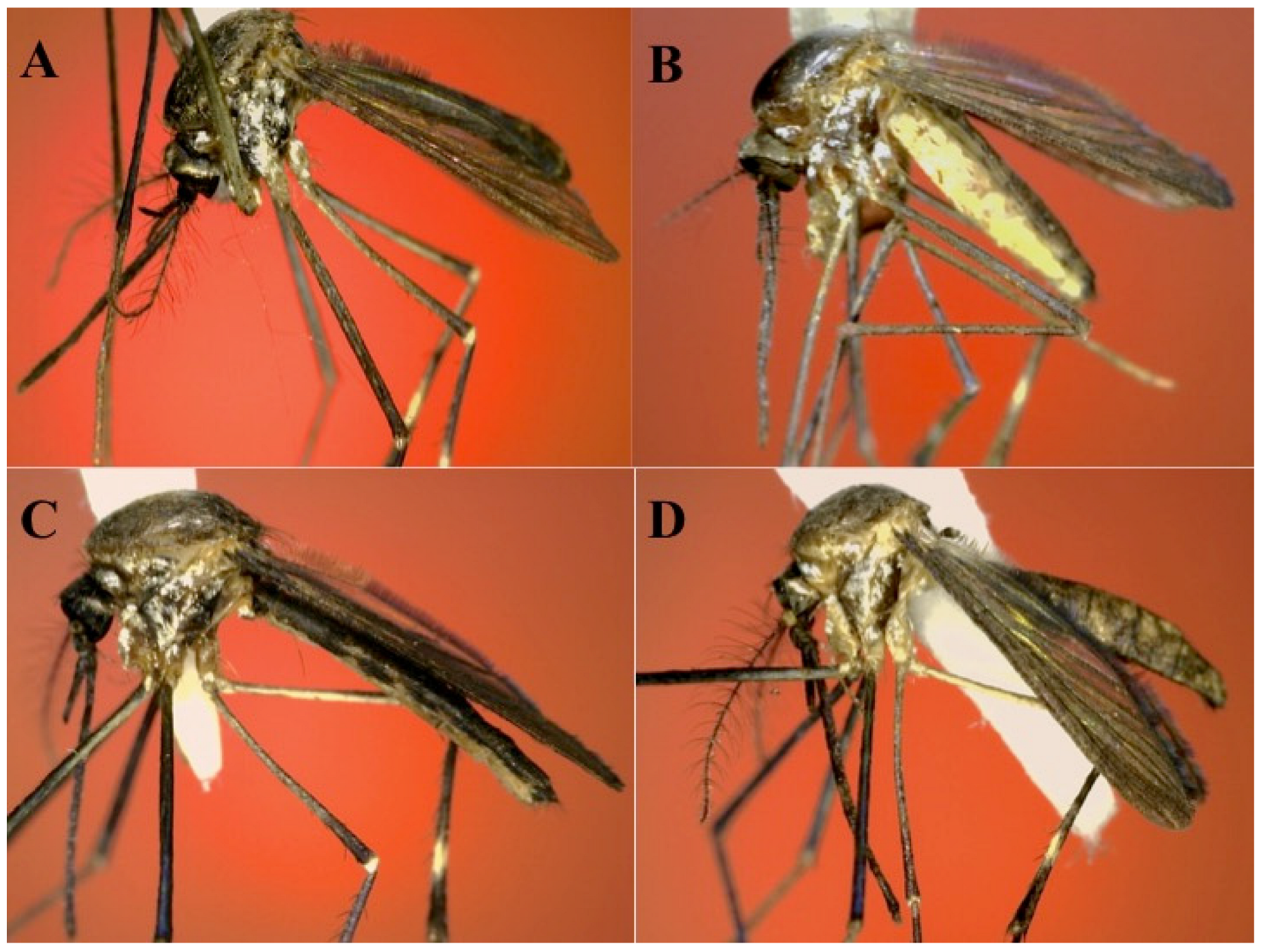
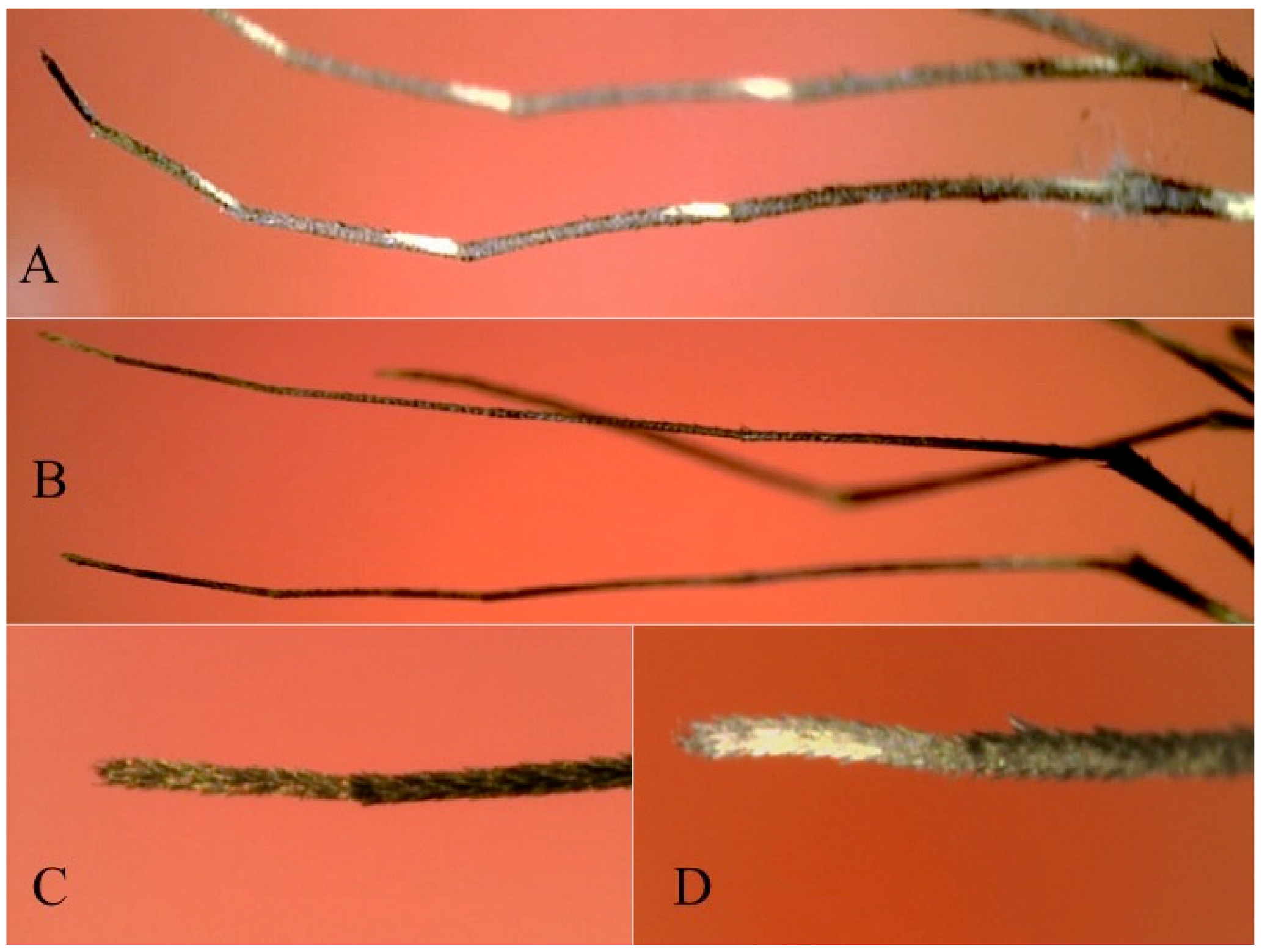
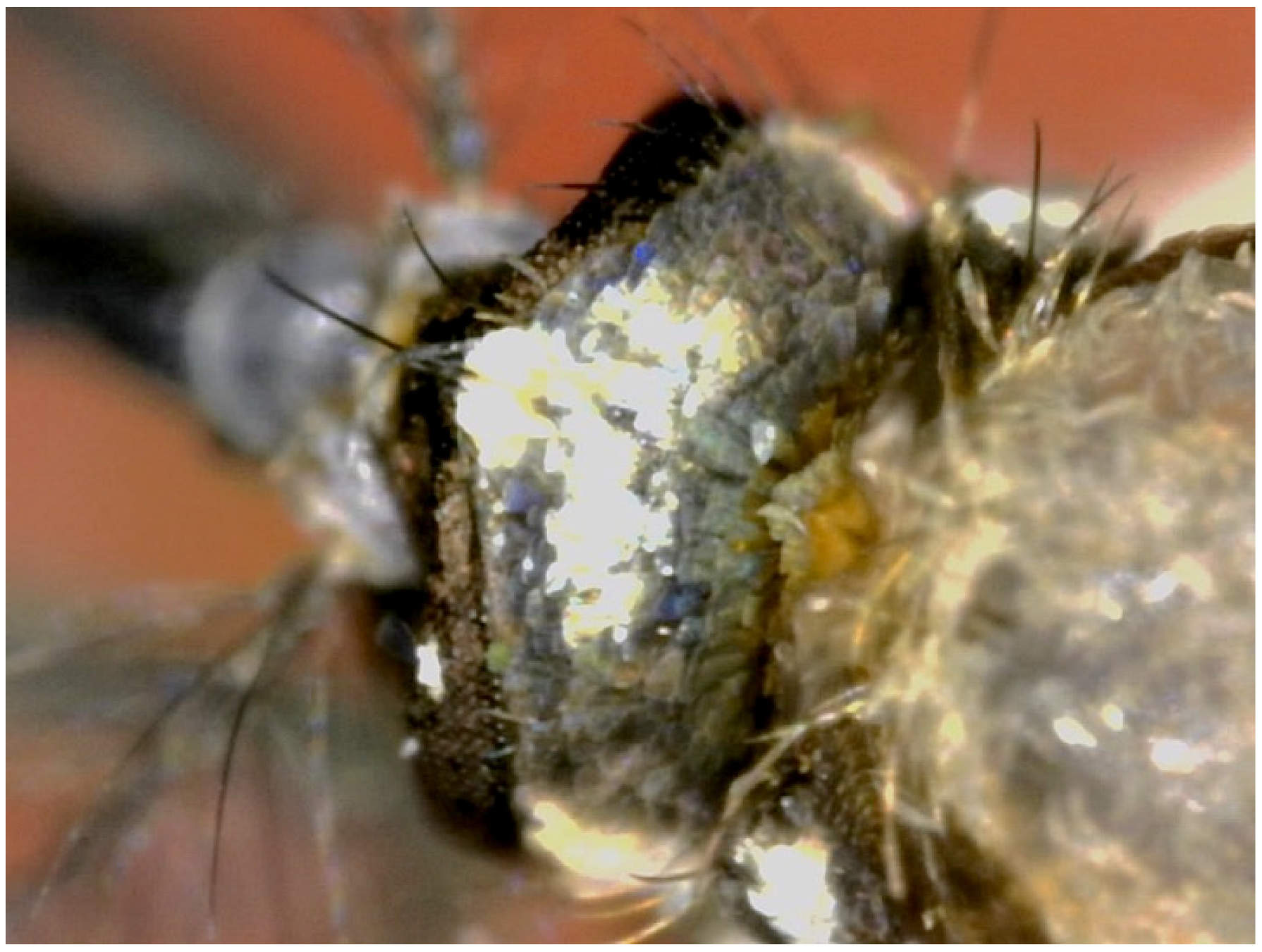
4. Discussion and Conclusions
4.1. Ecology and Distributional Groups of Species
4.1.1. Group 1
4.1.2. Group 2
4.1.3. Group 3
4.2. Species from Adjacent Regions That May Occur in Querétaro
4.3. Medical Importance of Mosquitoes of Querétaro
4.4. Molecular Analysis
4.5. Mosquitoes Diversity in Querétaro and Mexico
Author Contributions
Funding
Institutional Review Board Statement
Data Availability Statement
Acknowledgments
Conflicts of Interest
References
- Muñoz-Cabrera, L.O.; Ibáñez-Bernal, S.; Corona-Vargas, M.C. Los mosquitos (Diptera: Culicidae) de Tlaxcala, México. I: Lista comentada de especies. Folia Entomol. Mex. 2006, 45, 223–271. [Google Scholar]
- Ortega-Morales, A.I.; Mis-Ávila, P.C.; Elizondo-Quiroga, A.; Harbach, R.E.; Siller-Rodríguez, Q.K.; Fernández-Salas, I. The mosquitoes of Quintana Roo state, Mexico (Diptera: Culicidae). Acta Zool. Mex. 2010, 26, 33–46. [Google Scholar]
- Ordóñez-Sánchez, F.; Sánchez-Trinidad, A.; Mis-Ávila, P.; Canul-Amaro, G.; Fernández-Salas, I.; Ortega-Morales, A.I. Nuevos registros de mosquitos (Diptera: Culicidae) en algunas localidades de Campeche y Quintana Roo. Entomol. Mex. 2013, 12, 850–854. [Google Scholar]
- Chan-Chablé, R.J.; Ortega-Morales, A.I.; Martínez-Arce, A. First record of Psorophora albipes in Quintana Roo, Mexico. J. Am. Mosq. Control Assoc. 2016, 32, 237–239. [Google Scholar] [CrossRef]
- Ortega-Morales, A.I.; Casas-Martínez, M.; Bond, G.; Harbach, R.E. First records of Psorophora cilipes and Culex theobaldi in Quintana Roo, Mexico. J. Am. Mosq. Control Assoc. 2018, 34, 124–127. [Google Scholar] [CrossRef]
- Chan-Chablé, R.J.; Martínez-Arce, A.; Mis-Ávila, P.C.; Ortega-Morales, A.I. DNA barcodes and evidence of cryptic diversity of anthropophagous mosquitoes in Quintana Roo, Mexico. Ecol. Evol. 2019, 9, 4692–4705. [Google Scholar] [CrossRef]
- Chan-Chablé, R.J.; Martínez-Arce, A.; Ortega-Morales, A.I.; Mis-Ávila, P.C. New records and updated checklist of mosquito species in Quintana Roo, Mexico, using DNA-Barcoding. J. Am. Mosq. Control Assoc. 2020, 36, 264–268. [Google Scholar] [CrossRef]
- Canto-Mis, K.L.; Chan-Chablé, R.J.; Gómez-Rivera, A.S.; López-Sosa, X.Y.; González-Acosta, C.; Correa-Morales, F.; Mis-Ávila, P.C. Nuevos registros de distribución para Uranotaenia sapphirina (Osten Sacken, 1868) (Diptera: Culicidae) en Quintana Roo, México. Rev. Chil. Entomol. 2021, 47, 613–617. [Google Scholar]
- Canto-Mis, K.L.; Gómez-Rivera, A.S.; Chan-Chablé, R.J.; González-Acosta, C.; Correa-Morales, F.; Mis-Ávila, P.C. Primer registro de distribución para Psorophora varipes (Coquillett, 1904) (Diptera: Culicidae) en Quintana Roo, México. Rev. Chil. Entomol. 2022, 48, 293–297. [Google Scholar]
- Ibáñez-Bernal, S.; Mendoza-Palmero, F.S.; Hernández-Xoliot, R.A. Mosquitos (Insecta: Diptera: Culicidae). In La Biodiversidad de Veracruz Estudio de Estado, Vol. II; Cruz-Angón, A., Lorca-Hernández, F.G., Hernández-Ortiz, V., Morales-Mavil., J.E., Eds.; Comisión Nacional para el Conocimiento y Uso de la Biodiversidad CONABIO: Mexico City, México, 2011; pp. 399–403, Appendix 5–8. [Google Scholar]
- Mendez-Andrade, A.; Rivera-García, K.D.; Ibáñez-Bernal, S. Notes on the Toxorhynchites of Mexico: Redescription of Tx. moctezuma (Dyar & Knab) and new record for Tx. grandiosus (Williston) in Veracruz (Diptera: Culicidae). Zootaxa 2019, 4576, 140–150. [Google Scholar]
- Rivera-García, K.D.; Méndez-Andrade, A.; Ibáñez-Bernal, S. Trichoprosopon mixtli sp. nov., a new sabethini species (Diptera: Culicidae) from a Mexican cloud forest, with an assessment of the genus and keys for the identification pk known species. Zootaxa 2023, 5254, 94–116. [Google Scholar] [CrossRef] [PubMed]
- Ortega-Morales, A.I.; Zavortink, T.J.; Huerta-Jiménez, H.; Sánchez-Rámos, F.J.; Valdés-Perezgasga, M.T.; Reyes-Villanueva, F.; Siller-Rodríguez, Q.; Fernández-Salas, I. Mosquito records from Mexico: The mosquitoes (Diptera: Culicidae) of Tamaulipas state. J. Med. Entomol. 2015, 52, 171–184. [Google Scholar] [CrossRef] [PubMed]
- Ortega-Morales, A.I.; Zavortink, T.J.; Huerta-Jiménez, H.; Ibáñez-Bernal, S.; Siller-Rodríguez, Q.K. The mosquitoes (Diptera: Culicidae) of Hidalgo state, Mexico. Acta Trop. 2019, 189, 94–103. [Google Scholar] [CrossRef] [PubMed]
- Ortega-Morales, A.I.; Pérez-Paredes, M.G.; Siller-Rodríguez, Q.K.; Moreno-García, M.; González-Acosta, C.; Correa-Morales, F. First record of Aedes gabriel in Hidalgo state, Mexico. J. Am. Mosq. Control Assoc. 2019, 35, 51–54. [Google Scholar] [CrossRef]
- Ortega-Morales, A.I.; Zavortink, T.J.; Garza-Hernández, J.A.; Siller-Rodríguez, Q.K.; Fernández-Salas, I. The mosquitoes (Diptera: Culicidae) of Nuevo León, Mexico, with descriptions of two new species. PLoS ONE 2019, 14, e0217694. [Google Scholar] [CrossRef]
- Villegas-Ramírez, H.M.; Ortega-Morales, A.I.; Flores-Suárez, A.; Fernández-Salas, I.; Ponce-García, G. First record of Aedes podographicus in Nuevo León state, Mexico. J. Am. Mosq. Control Assoc. 2021, 37, 87–89. [Google Scholar] [CrossRef]
- Ortega-Morales, A.I.; Morillón-Borjón, G.; Morales-Avitia, I.J.; Sánchez-García, A.A.; Ayala-Sulca, Y.O.; Sánchez-Rámos, F.J. First record of Wyeomyia mitchellii in Nuevo León, Mexico. J. Am. Mosq. Control Assoc. 2022, 38, 216–218. [Google Scholar] [CrossRef]
- Torres-Chable, O.M.; Baak-Baak, C.M.; Cigarroa-Toledo, N.; Zaragoza-Vera, C.V.; Arjona-Jiménez, G.; Moreno-Perez, L.G.; Machain-Williams, C.; García-Rejon, J. Mosquito fauna un home environments of Tabasco, Mexico. Southwest. Entomol. 2017, 42, 969–982. [Google Scholar] [CrossRef]
- Ortega-Morales, A.I.; Méndez-López, R.; Garza-Hernández, J.A.; González-Álvarez, V.H.; Ruiz-Arrondo, I.; Huerta-Jiménez, H.; Rodríguez-Martínez, L.M.; Rodríguez-Pérez, M.A. The mosquitoes (Diptera: Culicidae) of Tabasco, Mexico. J. Vector Ecol. 2019, 44, 57–67. [Google Scholar] [CrossRef]
- Rodríguez-Martínez, L.M.; Yzquierdo-Gómez, P.; González-Acosta, C.; Correa-Morales, F. First record of Aedes (Ochlerotatus) fulvus in Tabasco and distribution notes of other Aedes in Mexico. Southwest. Entomol. 2020, 45, 263–268. [Google Scholar] [CrossRef]
- Ortega-Morales, A.I.; Rodríguez-Martínez, L.M.; Méndez-Alvarado, W.; Garza-Hernández, J.A.; López-Hernández, I.; Medrano-Santillana, M.; González-Acosta, C.; Correa-Morales, F. The distribution of Uranotaenia sapphirina and Ur. socialis in Tabasco, southern Mexico. J. Am. Mosq. Control Assoc. 2022, 38, 141–147. [Google Scholar] [CrossRef] [PubMed]
- Dampf, A. Distribución y ciclo annual de Uranotaenia syntheta Dyar & Shannon en México y descripción del hipopigio masculine (Insecta, Diptera). Rev. Soc. Mex. Hist. Nat. 1943, 4, 147–170. [Google Scholar]
- Dávalos-Becerril, E.; Correa-Morales, F.; González-Acosta, C.; Santos-Luna, R.; Peralta-Rodríguez, J.; Pérez-Rentería, C.; Ordóñez-Álvarez, R.; Huerta, H.; Carmona-Perez, M.; Díaz-Quiñonez, J.A.; et al. Urban and semi-urban mosquitoes of Mexico City: A risk for endemic mosquito borne-disease transmission. PLoS ONE 2019, 14, e0212987. [Google Scholar] [CrossRef] [PubMed]
- Adeniran, A.A.; Hernández-Triana, L.M.; Ortega-Morales, A.I.; Garza-Hernández, J.A.; de la Cruz-Ramos, J.; Chan-Chablé, R.J.; Vázquez-Marroquín, R.; Huerta-Jiménez, H.; Nikolova, N.I.; Fooks, A.R.; et al. Identification of mosquitoes (Diptera: Culicidae) from Mexico State, Mexico using morphology and COI DNA barcoding. Acta Trop. 2021, 213, 105730. [Google Scholar] [CrossRef] [PubMed]
- Vargas, L.; Martínez-Palacios, A. Anofelinos mexicanos, taxonomía y distribución. In Anofelinos Mexicanos Taxonomia y Distribución; Secretaría de Salud: Ciudad de México, Mexico, 1956; p. 181. [Google Scholar]
- Vargas, L. Especies y distribución de mosquitos mexicanos no Anofelinos (Insecta, Diptera). Rev. Inst. Salubr. Enf. Trop. 1956, 1, 19–36. [Google Scholar]
- Díaz-Nájera, A.; Vargas, L. Mosquitos mexicanos: Distribución geográfica actualizada. Rev. Inv. Salud Pública. 1973, 33, 111–125. [Google Scholar]
- Ibáñez-Bernal, S.; Martínez-Campos, C. Clave para la aidentificación de larvas de mosquitos comunes en las áreas urbanas y suburbanas de la República Mexicana (Diptera: Culicidae). Folia Entomol. Mex. 1994, 92, 43–73. [Google Scholar]
- Sánchez-Trinidad, A.; Ordóñez-Sánchez, F.; Valdez-Perezgasga, M.T.; Sánchez-Ramos, F.J.; Zavortink, T.J.; Cortés-Guzman, A.J.; Ortega-Morales, A.I. Geographical distribution of the Aedes Triseriatus group (Diptera: Culicidae) in Mexico. J. Vector Ecol. 2014, 39, 134–137. [Google Scholar] [CrossRef]
- Quezada-Yaguachi, W.E.; Alquisira-Domínguez, M.; Vázquez-Anzúres, M.J.; Rebollo-Salinas, D.; Rescalvo-Luna, L.D.; Medina-Castañeda, A.; González-Acosta, C.; Correa-Morales, F.; Viveros-Santos, V.; Moreno-García, M. Nuevo registro de Haemagogus (Haemagogus) equinus Theobald, 1903 y otros mosquitos (Diptera: Culicidae) recolectados con ovitrampas en Jalpan de Serra, Querétaro, México. Rev. Chil. Entomol. 2023, 49, 73–81. [Google Scholar]
- Ortega-Morales, A.I.; Moreno-García, M.; González-Acosta, C.; Correa-Morales, F. Mosquito surveillance in Mexico: The use of ovitraps for Aedes aegypti, Ae. albopictus, and non-target species. Fla. Entomol. 2018, 101, 623–626. [Google Scholar] [CrossRef]
- Ortega-Morales, A.I.; Pérez-rentería, C.; Ordóñez-Álvarez, J.; Salazar, J.A.; Dzul-Manzanilla, F.; Correa-Morales, F.; Huerta-Jiménez, H. Update on the dispersal of Aedes albopictus in Mexico: 1988–2021. Front. Trop. Dis. 2022, 2, 72. [Google Scholar] [CrossRef]
- INEGI. Instituto Nacional de Estadística y Geografía. 2018. Available online: https://www.inegi.org.mx/app/cuadroentidad/Qro/2018/01/1_4 (accessed on 15 February 2023).
- Harbach, R.E.; Knight, K.L. Taxonomist’s Glossary of Mosquito Anatomy; Plexus Publishing, Inc.: Marlton, NJ, USA, 1980; ISBN 9780937548004. [Google Scholar]
- Knight, K.L.; Stone, A. A Catalog of the Mosquitoes of the World (Diptera: Culicidae); Thomas Say Foundation: College Park, MD, USA, 1977. [Google Scholar]
- Wilkerson, R.C.; Linton, Y.M.; Fonseca, D.M.; Schultz, T.R.; Price, D.C.; Strickman, D.A. Making mosquito taxonomy useful: A stable classification of Tribe Aedini that balances utility with current knowledge of evolutionary relationships. PLoS ONE 2015, 10, e0133602. [Google Scholar] [CrossRef]
- WRBU. Walter Reed Biosystematics Unit, Smithsonian Institution. 2005. Available online: http://www.wrbu.org (accessed on 15 November 2022).
- Folmer, O.; Black, M.; Hoeh, W.; Lutz, T.; Vrijenhoek, R. DNA Primers for amplification of mitochondrial Cytochrome c Oxidase Subunit I from diverse Metazoan Invertebrtes. Mol. Mar. Biol. Biotechnol. 1994, 3, 294–299. [Google Scholar]
- Prosser, W.J.S.; deWaard, J.R.; Miller, S.C.; Hebert, P.D.N. DNA barcodes from century-old type specimens using next generation sequencing. Mol. Ecol. Res. 2016, 16, 487–489. [Google Scholar] [CrossRef] [PubMed]
- Tamura, K.; Stoecher, G.; Peterson, N.; Filipski, A.; Kumar, S. MEGA6: Molecular evolutionary genetics analysis version 6.0. Mol. Biol. Evol. 2013, 30, 2725–2729. [Google Scholar] [CrossRef] [PubMed]
- Hebert, P.N.D.; Cywinska, A.; Ball, S.L.; deWaard, J.R. Biological identification through DNA barcodes. Proc. R. Soc. Biol. Sci. 2003, 270, 213–321. [Google Scholar] [CrossRef]
- Hebert, P.N.D.; Ratnasingham, S.; deWaard, J.R. Barcoding animal life: Cytochrome c oxidase subunit 1 divergences among closely related species. Proc. R. Soc. Biol. Sci. 2003, 270, 596–599. [Google Scholar] [CrossRef]
- Hall, T. BioEdit: A user-friendly biological sequence alignment editor analysis program for Windows 95/98/NT. Nucelic Acids Symp. Ser. 1999, 41, 95–98. [Google Scholar]
- Larkin, M.A.; Blackshields, G.; Brown, N.P.; Chenna, R.; McGettigan, P.A.; McWilliam, H.; Valentin, F.; Wallace, I.M.; Wilm, A.; Lopez, R.; et al. Clustal W and Clustal X version 2.0. Bioinformatics 2007, 23, 2947–2948. [Google Scholar] [CrossRef]
- Hernández-Triana, L.M.; Brugman, V.A.; Nikolova, N.I.; Ruiz-Arrondo, I.; Barrero, E.; Thorne, T.; de Marco, M.F.; Kruger, A.; Lumley, S.; Johnson, N.; et al. DNA barcoding of British mosquitoes (Diptera, Culicidae) to support species identification, discovery of cryptic genetic diversity and monitoring invasive species. Zookeys 2019, 832, 57–76. [Google Scholar] [CrossRef]
- Laurito, M.; Briscoe, A.G.; Almirón, W.R.; Harbach, R.E. Systematics of the Culex coronator complex (Diptera: Culicidae): Morphological and molecular assessment. Zool. J. Linn. Soc. 2018, 182, 735–757. [Google Scholar] [CrossRef]
- Clark-Gil, S.; Darsie, R.F. The mosquitoes of Guatemala, their identification, distribution and bionomics, with keys to adult female and larvae. Mosq. Syst. 1983, 15, 151–294. [Google Scholar]
- Lane, J.; Cerquiera, N.L. Os Sabetíneos de América (Diptera, Culicidae). Arq. Zool. Sáo Paulo 1942, 9, 473–849. [Google Scholar]
- Wilkerson, R.C.; Linton, T.-M.; Strickman, D. Mosquitoes of the World; Johns Hopkins University Press: Baltimore, MD, USA, 2021; Volume 2. [Google Scholar]
- Vargas, L.; Martínez-Palacios, A. Descripción de Wyeomyia (Wyeomyia) stonei, n. sp., y notas sobre otros Sabethini de Mexico. Rev. Inst. Salubr. Enf. Trop. 1953, 4, 293–307. [Google Scholar]
- Díaz-Nájera, A. Mosquitos tropicales de Mexico. Rev. Invest. Salud Publ. 1966, 1, 57–63. [Google Scholar]
- Viveros-Santos, V.; Hernández-Triana, L.M.; Ibáñez-Bernal, S.; Ortega-Morales, A.I.; Nikolova, N.I.; Pairot, P.; Fooks, A.R.; Casas-Martínez, M. Integrated approaches for the identification of mosquitoes (Diptera: Culicidae) from the volcanoes of Central America Physiographic subprovence of the state of Chiapas, Mexico. Vector Borne Zoonotic Dis. 2022, 22, 120–137. [Google Scholar] [CrossRef]
- Vargas, L. Notas sobre mosquitos nuevos para Mexico. Rev. Inst. Salubr. Enf. Trop. 1939, 1, 101–104. [Google Scholar]
- Díaz-Nájera, A. Variaciones morfológicas en larvas de dos especies de Trichoprosopon y datos sobre su distribución. Rev. Inst. Salubr. Enf. Trop. 1961, 3–4, 201–219. [Google Scholar]
- Hernández-Triana, L.M.; Garza-Hernández, J.A.; Ortega Morales, A.I.; Prosser, S.W.; Hebert, P.D.; Nikolova, N.I.; Barrero, E.; de Luna-Santillana, E.D.J.; González-Alvarez, V.H.; Mendez-López, R.; et al. An integrated molecular approach to untangling host-vector-pathogen interactions in mosquitoes (Diptera: Culicidae) from sylvan communities in Mexico. Front. Vet. Sci. 2021, 7, 564791. [Google Scholar] [CrossRef]
- Talaga, S.; Leroy, C.; Guidez, A.; Dusfour, I.; Girod, R.; Dejean, A.; Murienne, J. DNA reference libraries of French Guianese mosquitoes for barcoding and metabarcoding. PLoS ONE 2017, 12, e0176993. [Google Scholar] [CrossRef]
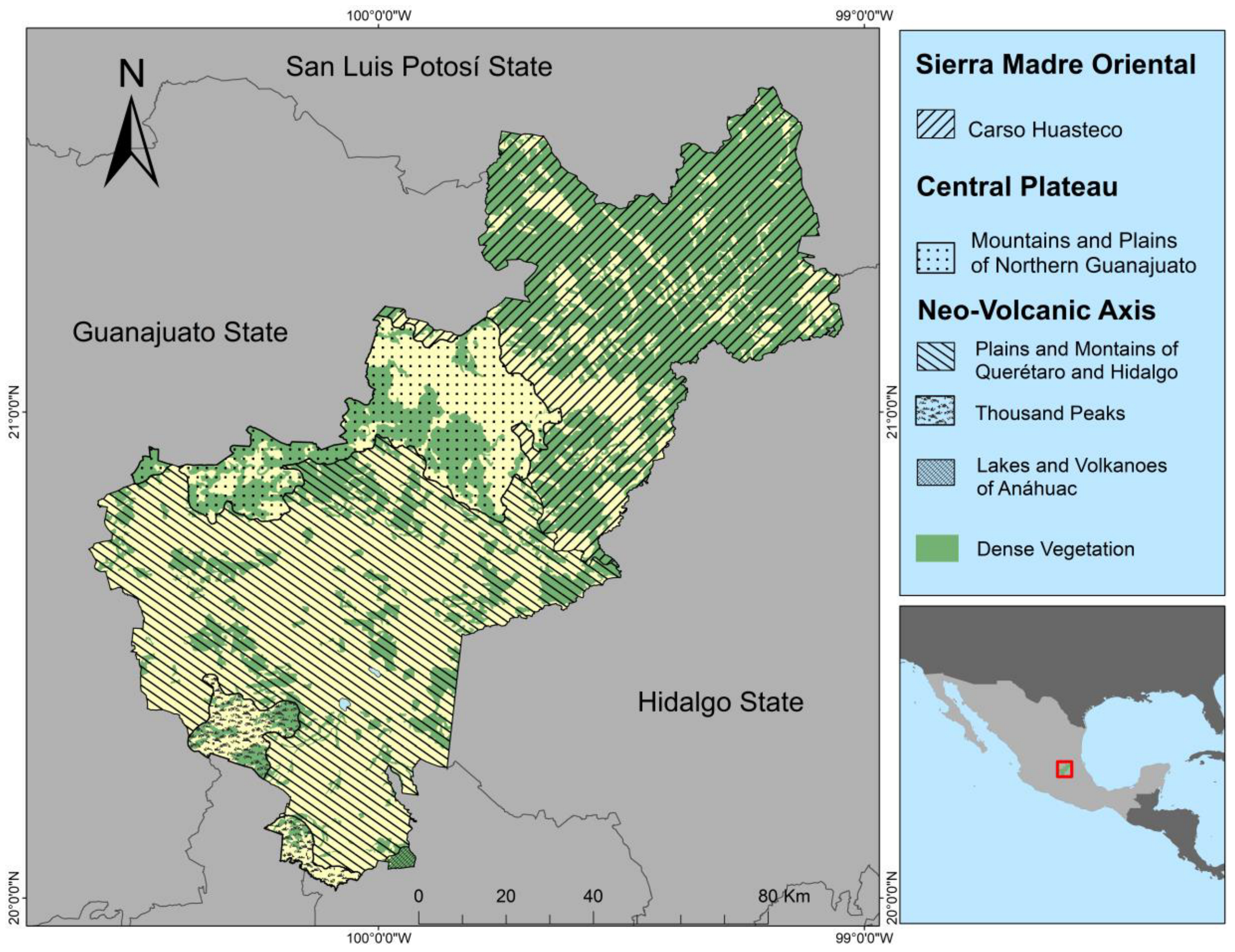
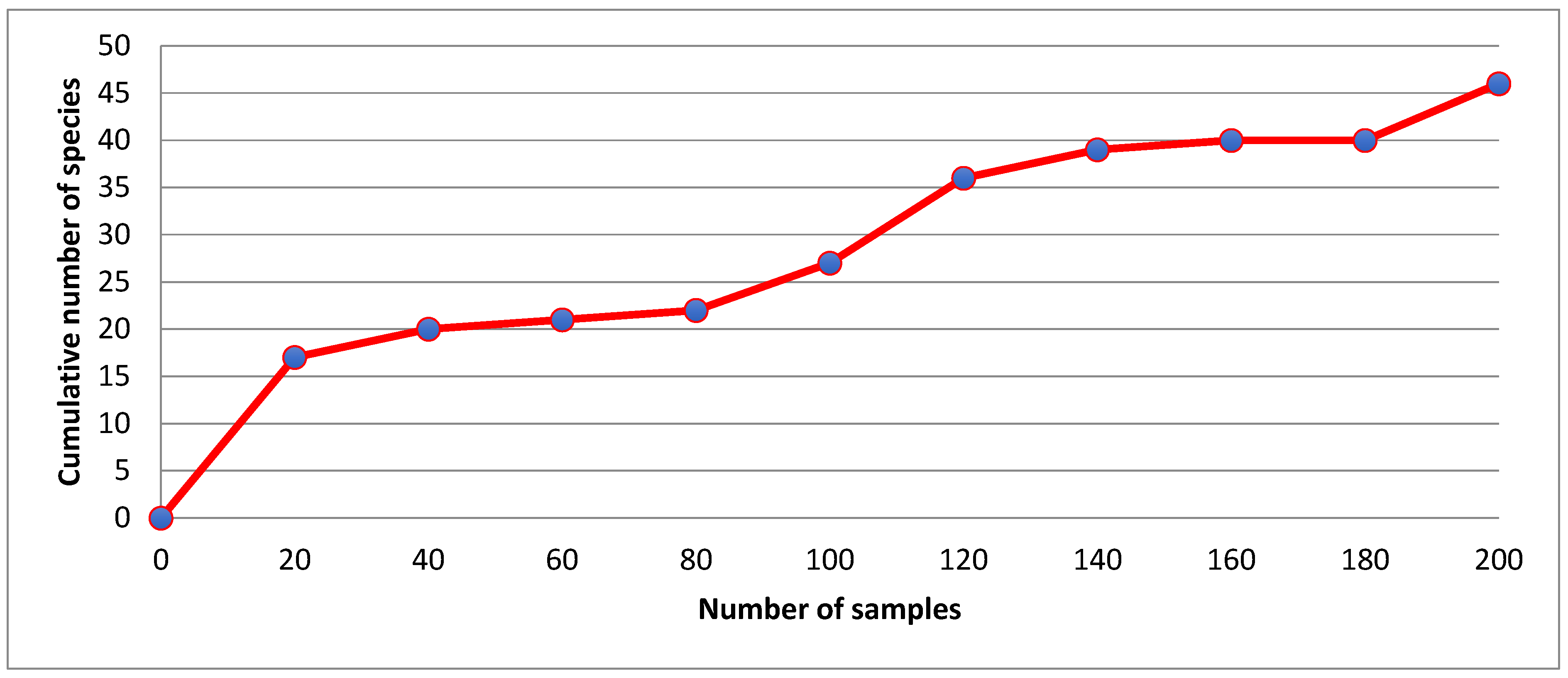
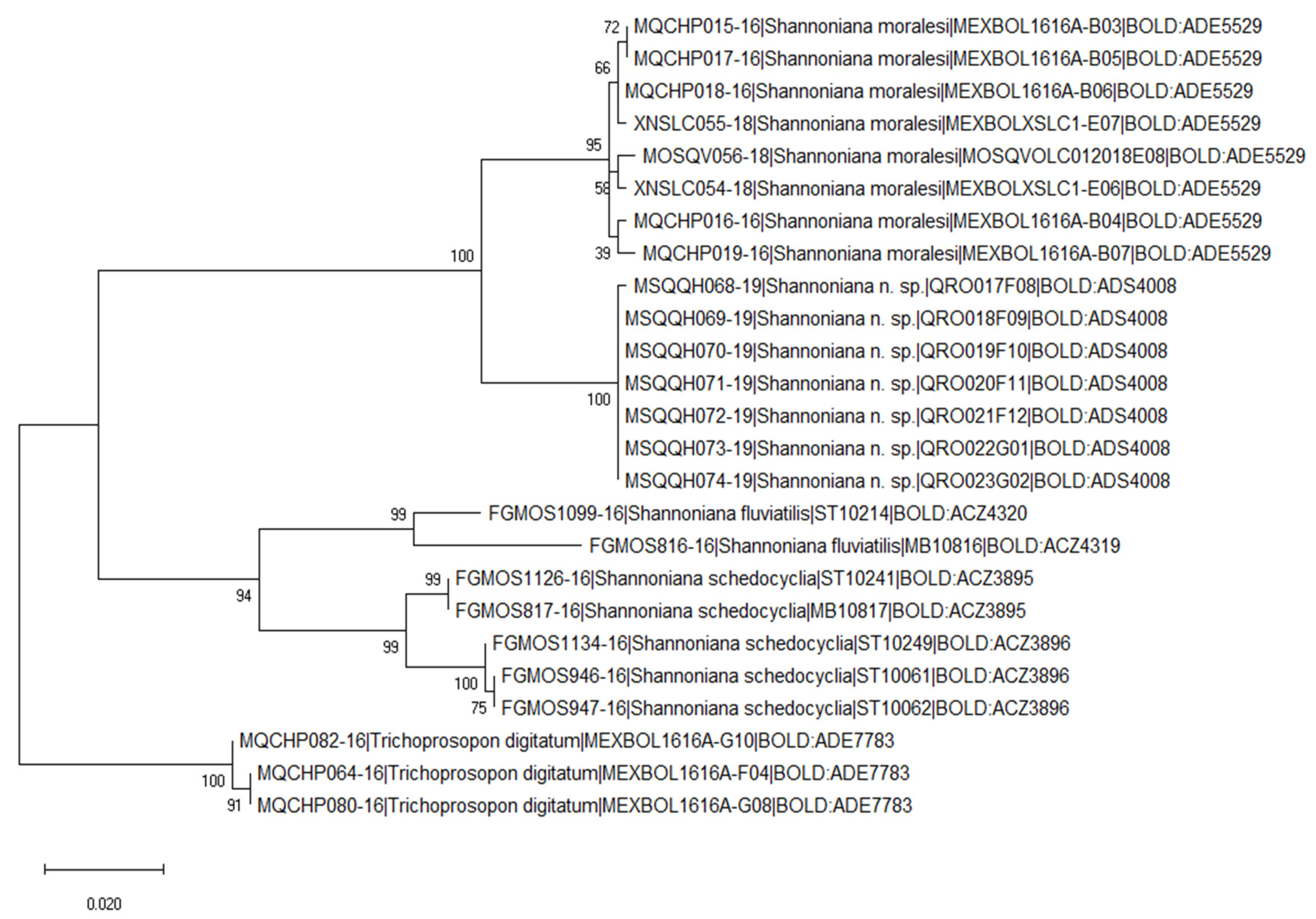
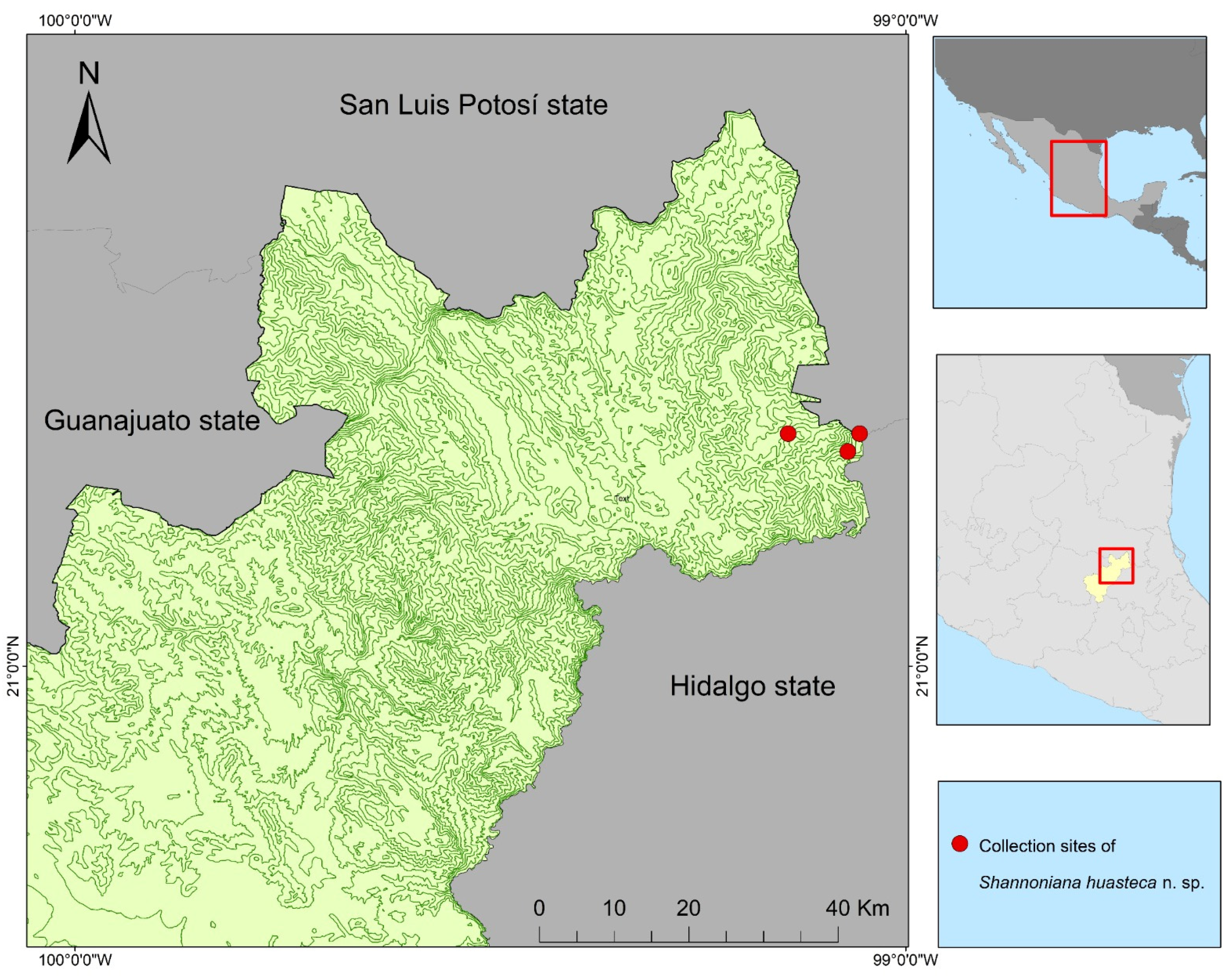
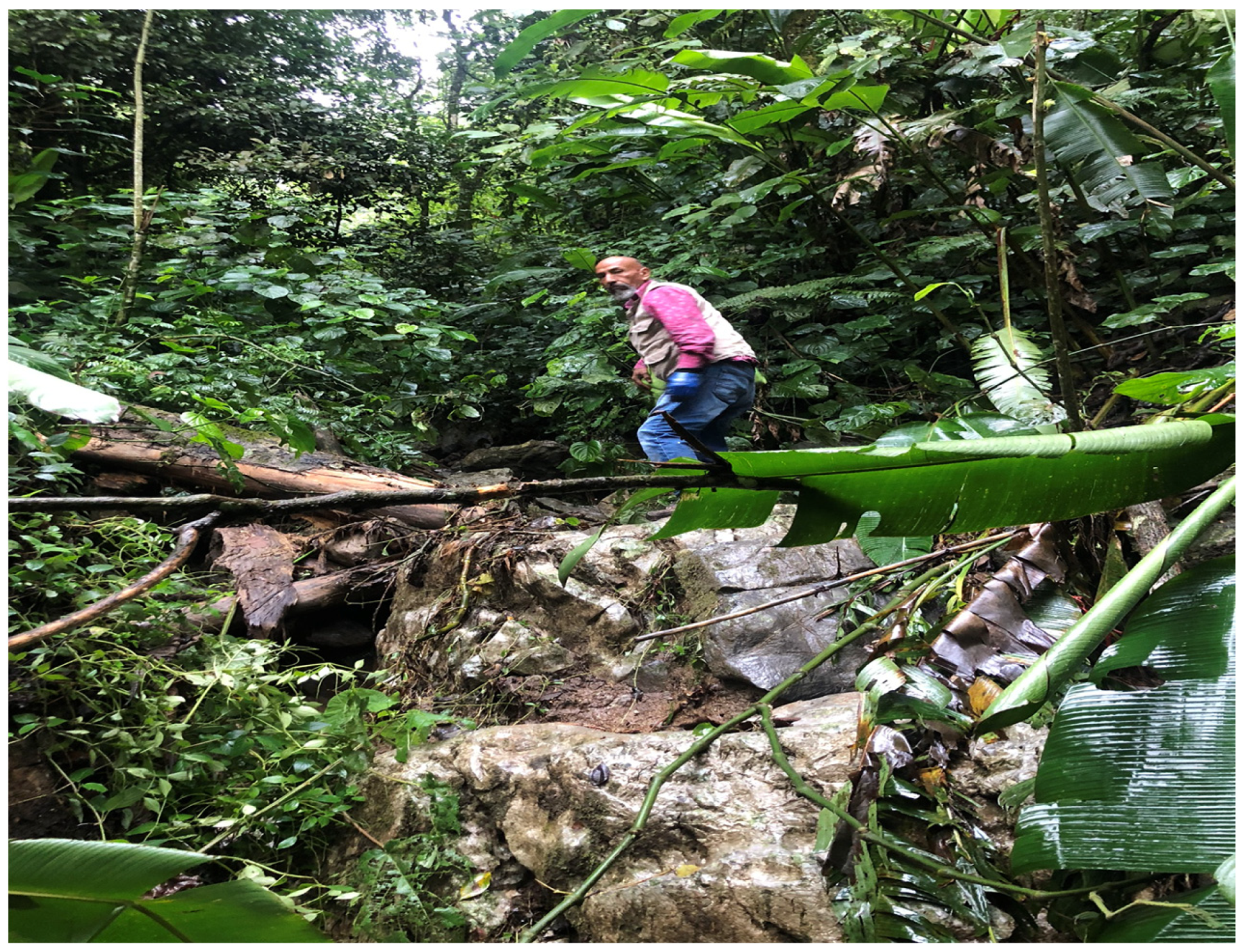
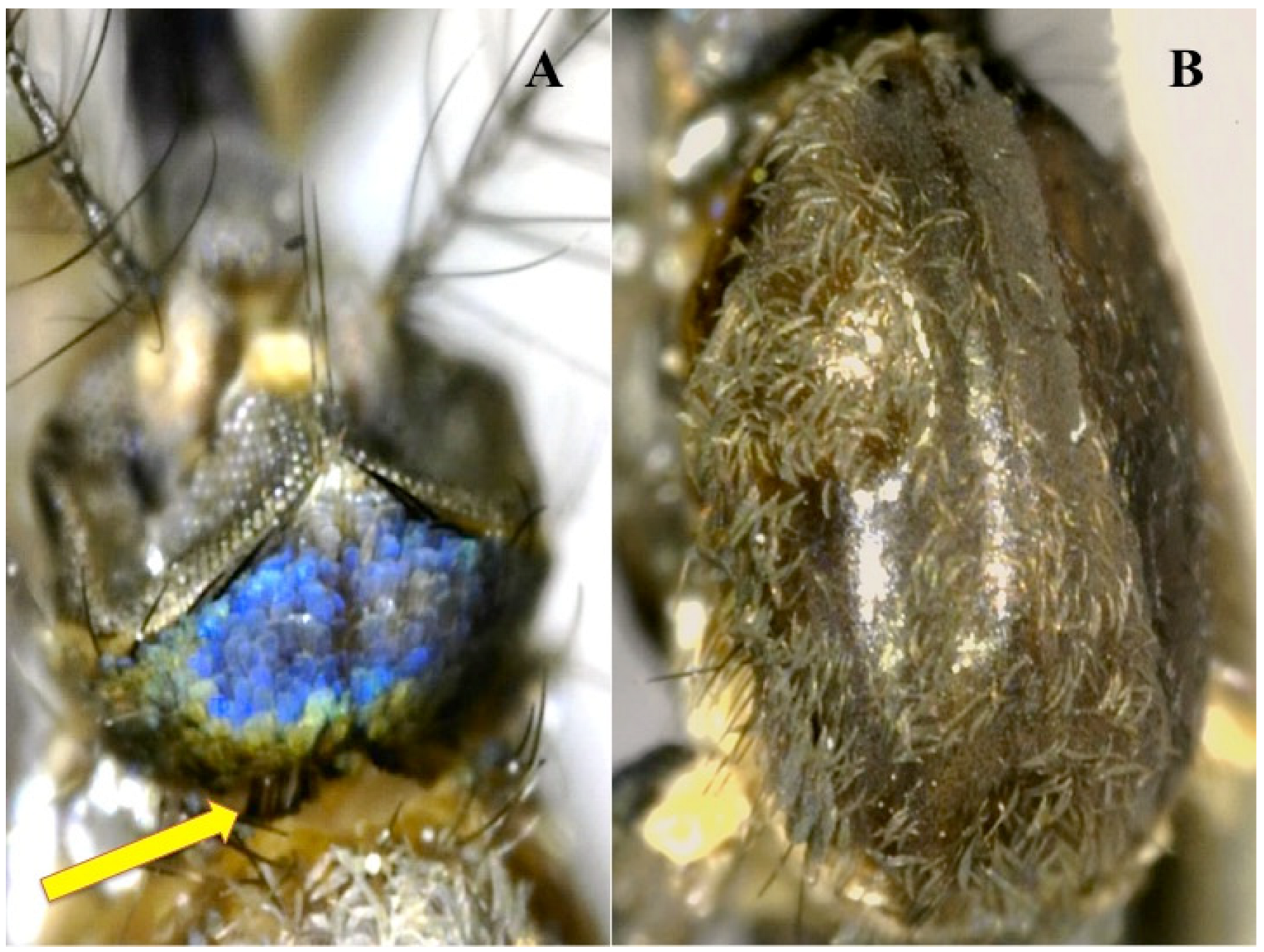
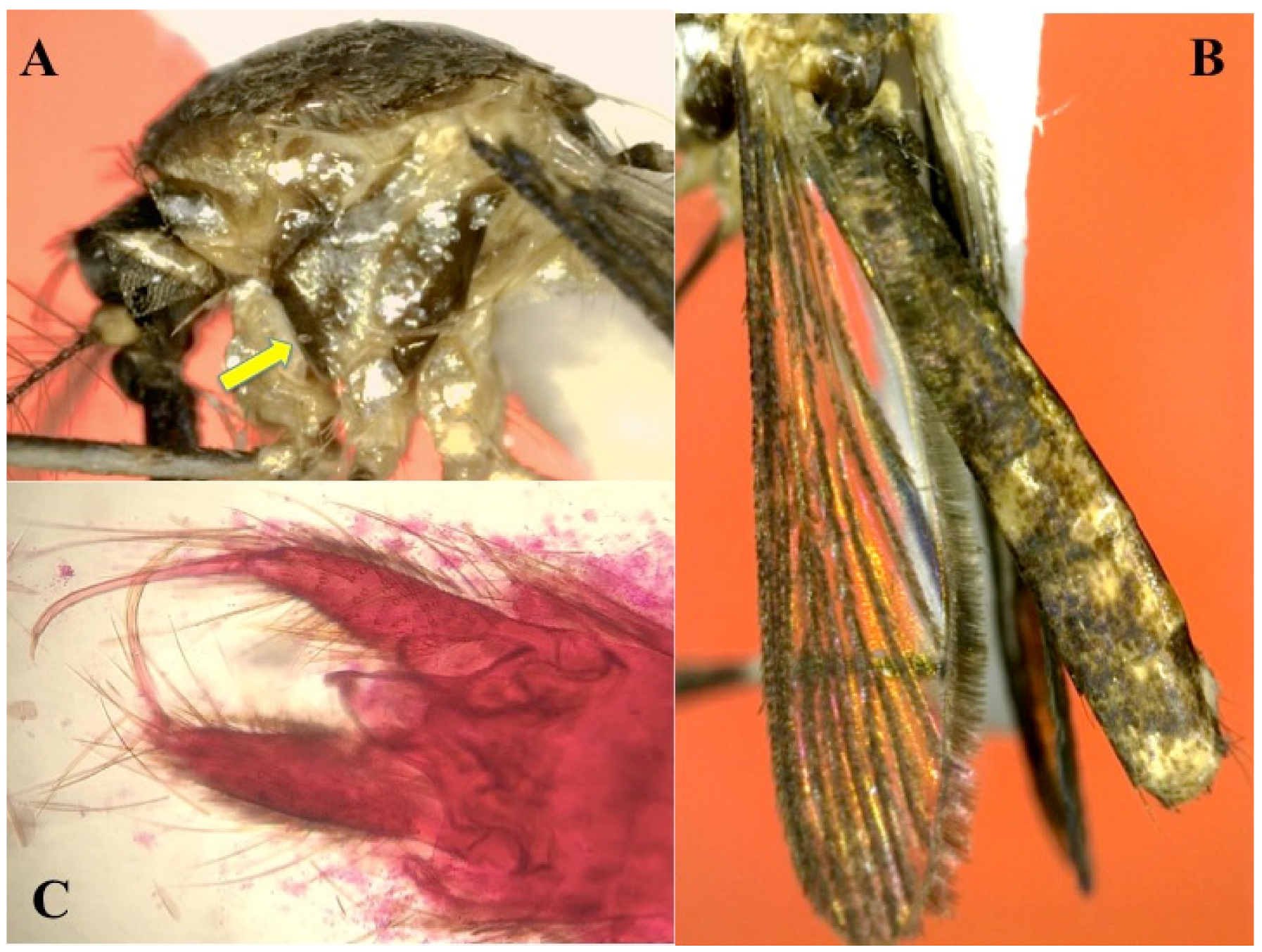
| Taxa | F.R. | Taxa | F.R. |
|---|---|---|---|
| Anopheles (Anopheles) | 26. Cx. coronator Dyar and Knab | NSR | |
| 1. An. apicimacula Dyar and Knab | NSR | 27. Cx. declarator Dyar and Knab | NSR |
| 2. An. eiseni Coquillett | NSR | 28. Cx. erythrothorax Dyar | NSR |
| 3. An. franciscanus McCracken | NSR | 29. Cx. quinquefasciatus Say | D-NV |
| 4. An. pseudopunctipennis Theobald | VM-P | 30. Cx. restuans Theobald | NSR |
| 5. An. punctipennis (Say) | VM-P | 31. Cx. salinarius Coquillett | NSR |
| Anopheles (Nyssorhynchus) | 32. Cx. stigmatosoma 2 Dyar | D-NV | |
| 6. An. albimanus Wiedemann | IBMC | 33. Cx. tarsalis Coquillett | NSR |
| Aedes (Aedimorphus) | 34. Cx. thriambus Dyar | NSR | |
| 7. Ae. vexans (Meigen) | V | Culex (Melanoconion) | |
| Aedes (Georgecriagius) | 35. Cx. erraticus (Dyar and Knab) | NSR | |
| 8. Ae. epactius 1 Dyar and Knab | D-NV | 35. Cx. peccator Dyar and Knab | NSR |
| Aedes (Howardina) | Culex (Neoculex) | ||
| 9. Ae. allotecnon Kumm, Komp, and Ruiz | V | 36. Cx. apicalis Adams | NSR |
| 10. Ae. quadrivittatus (Coquillett) | NSR | 37. Cx. arizonensis Bohart | NSR |
| Aedes (Ochlerotatus) | Culex (Phenacomyia) | ||
| 11. Ae. angustivittatus Dyar and Knab | NSR | 38. Cx. lactator Dyar and Knab | NSR |
| 12. Ae. euplocamus Dyar and Knab | NSR | Lutzia (Lutzia) | |
| 13. Ae. scapularis (Rondani) | D-NV | 40. Lt. bigoti (Bellardi) | NSR |
| 14. Ae. shannoni Vargas and Downs | V | Culiseta (Culiseta) | |
| 15. Ae. trivittatus (Coquillett) | V | 41. Cs. inornata (Williston) | NSR |
| Aedes (Protomacleaya) | 42. Cs. particeps (Adams) | NSR | |
| 16. Ae. amabilis Schick | NSR | 43. Cs. n. sp. | NS |
| 17. Ae. brelandi Zavortink | STEA | Limatus | |
| 18. Ae. podographicus Dyar and Knab | OMEA a | 44. Li. durhamii Theobald | NSR |
| 19. Ae. schicki Zavortink | NSR | Sabethes (Sabethoides) | |
| 20. Ae. triseriatus (Say) | STEA | 45. Sa. chloropterus (von Humboldt) | NSR |
| Aedes (Stegomyia) | Shannoniana | ||
| 21. Ae. aegypti (Linneaus) | IBMC | 46. Sh. huasteca n. sp. | NS |
| 22. Ae. albopictus (Skuse) | OMEA b | Wyeomyia (Triamyia) | |
| Haemagogus (Haemagogus) | 47. Wy. aporonoma Dyar and Knab | NSR | |
| 23. Hg. equinus Theonald | WEEA | Wyeomyia (Wyeomyia) | |
| Psorophora (Grabhamia) | 48. Wy. adelpha/guatemala | NSR | |
| 24. Ps. signipennis (Coquillett) | NSR | 49. Wy. mitchellii (Theobald) | NSR |
| Culex (Anoedioporpa) | Toxorhynchites (Lynchiella) | ||
| 25. Cx. restrictor Dyar and Knab | NSR | 50. Tx. moctezuma (Dyar and Knab) | NSR |
| Culex (Culex) |
| Region (Subregion) | Municipalities Sampled | Description of Subregions |
|---|---|---|
| Sierra Madre Oriental (Carso Huasteco) | Arroyo Seco, Jalpan de Serra, Landa de Matamoros, Peñamiller, Pinal de Amoles, San Joaquín, | Located in the south of the Sierra Madre Oriental, extends from San Luis Potosí and Guanajuato states to Querétaro, Hidalgo, Veracruz, and Puebla states. This subregion includes cloud and tropical forests, with oak and pine predominate. |
| Central Plateau (Mountains and Plains of Northern Guanajuato) | Cadereyta de Montes | This region is characterized by being an elevated region made up of wide plains interrupted by scattered mountain ranges, covered for the most part by Cenozoic volcanic rocks. Its average altitude is from 1700 to 2300 m above sea level. |
| Neo-Volcanic Axis (Plains and Mountains of Querétaro and Hidalgo) | Amealco de Bonfil, Cadereyta de Montes, Colón, Corregidora, El Marqués, Ezequiel Montes, Huimilpan, Pedro Escobedo, San Juan del Río, Santiago de Querétaro, Tequisquiapan, Tolimán | This subregion is an area of rough terrain where rounded hills predominate, some reaching elevations of 2400 m; the weather is dry and semi-warm, with warm temperatures during the summer, and cold during the winter. Includes grasslands and shrublands. |
| Neo-Volcanic Axis (Thousand Peaks) | Huimilpan | This small subregion has mountainous relief that is made up of volcanic mountains, staggered lava plateaus, basaltic hills and the wide valley of the Lerma River. The climate is temperate and warm sub-humid, the rains occurring between June and October. |
| Neo-Volcanic Axis (Lakes and Volcanoes of Anáhuac) | Amealco de Bonfil | This subregion has a relief with hills and mountains with elevations above 3000 m; the climate is temperate humid, cool in summer. There are extensive regions of pine and oak forest, as well shrublands and grasslands. |
| Taxa | Collection Date | Collection Site | Habitat | Aquatic Parameters | Associated Species | ||||
|---|---|---|---|---|---|---|---|---|---|
| Latitude N | Longitude W | Elev. | pH | Temp | Salts | ||||
| An. apicimacula | 17 July 2015 | 20°4′41.2″ | 100°6′2.0″ | 1949 | Resting on peri-domiciliary | ---- | ---- | ---- | ----- |
| An. franciscanus | 14 November 2012 | 20°8′53.3″ | 99°58′38.5″ | 2329 | Stream margin with clear water, green algae and total shade | 6.40 | 14.5 | 66 | Ae. epactius, Cx. apicalis |
| 14 November 2012 | 20°9′10.7″ | 100°1′9.6″ | 2463 | Pond with colored water, brown algae and partial shade | 6.55 | 17.2 | 100 | Cx. tarsalis | |
| 15 November 2012 | 20°6′41.9″ | 100°6′46.9″ | 2556 | Swamp with colored water, green algae and absent shade | 7.48 | 15.3 | 90 | ----- | |
| 16 November 2012 | 20°44′38.5″ | 99°56′19.7″ | 2058 | Spring with clear water, floating vegetation and total shade | 7.18 | 14.1 | 720 | ----- | |
| 16 November 2012 | 20°53′30.1″ | 99°41′44.1″ | 1539 | Pond with clear water, green algae and absent shade | 7.19 | 25.8 | 701 | ----- | |
| 17 November 2012 | 21°1′52″ | 99°36′2.3″ | 562 | Pond with clear water, green algae and partial shade | 7.22 | 24.8 | 277 | An. pseudopunctipennis, Cx. coronator, Cx. restuans | |
| 17 July 2015 | 20°24′41.2″ | 100°6′2″ | 1949 | Pond with clear water, aquatic vegetation, green brown and partial shade | 8 | 21 | 535 | Cx. stigmatosoma | |
| Ae. quadrivittatus | 27 September 2012 | 21°13′7″ | 99°5′42″ | 368 | Bromeliad axil with colored water and abundant leaf at bottom, total shade | 6.60 | 26.4 | 22 | Ae. aegypti, Wy. mitchellii |
| 27 September 2012 | 21°13′7″ | 99°5′42″ | 368 | Bromeliad axil with colored water and abundant leaf at bottom | 6.99 | 24.7 | 12 | Ae. allotecnon, Wy. mitchellii | |
| 27 September 2012 | 21°16′14.4″ | 99°3′20.1″ | 897 | Human biting/landing at day with total shade | ---- | ---- | ---- | Ae. allotecnon, Ae. podographicus, Sa. chloropterus, Sh. huasteca, Wy. mitchellii | |
| 19 November 2012 | 21°34′18.8″ | 99°14′33.3″ | ---- | Human biting/landing at day with total shade | ---- | ---- | ---- | Ae. trivittatus, Ae. amabilis | |
| 20 November 2012 | 21°34′53.6″ | 99°14′6.8″ | 686 | Human biting/landing at day with total shade | ---- | ---- | ---- | Ae. trivittatus, Ae. amabilis, Ae. brelandi, Sa. chloropterus, Wy. mitchellii | |
| 20 November 2012 | 21°34′18.8″ | 99°14′33.3″ | 766 | Human biting/landing at day with total shade | ---- | ---- | ---- | Ae. triseriatus, Ae. amabilis | |
| 24 September 2018 | 21°15′29.3″ | 99°411.1″ | 1010 | Human biting/landing at day with total shade | ---- | ---- | ---- | Ae. allotecnon, Sh. huasteca, Wy. mitchellii | |
| Ae. angustivittatus | 28 September 2012 | 21°30′59″ | 99°17′13.3″ | 1033 | Human biting/landing at day with total shade | ---- | ---- | ---- | Ae. trivittatus, Ae. allotecnon, Ae. amabilis, Ae. brelandi |
| Ae. euplocamus | 28 September 2012 | 21°18′48″ | 99°16′21.7″ | 965 | Rain gutter with colored water, leaves at bottom and total shade | 9.70 | 27.6 | 58 | Ae. epactius, Ae. shannoni |
| 20 November 2012 | 21°34′27.7″ | 99°12′39.8″ | 715 | Rock hole with clear water, leaves at bottom and total shade | 7.63 | 24 | 162 | Ae. epactius, Cx. coronator | |
| Ae. amabilis | 28 September 2012 | 21°30′32.7″ | 99°17′22.2″ | 965 | Human biting/landing at day with total shade | ---- | ---- | ---- | ----- |
| 28 September 2012 | 21°30′59″ | 99°17′13.3″ | 1033 | Human biting/landing at day with total shade | ---- | ---- | ---- | Ae. angustivittatus, Ae. trivittatus, Ae. allotecnon, Ae. brelandi | |
| 19 November 2012 | 21°30′59″ | 99°17′13.3″ | 686 | Shannon trap baited with human at day | Ae. trivittatus, Ae. triseriatus | ||||
| 19 November 2012 | 21°34′18.8″ | 99°14′33.3″ | ---- | Human biting/landing at day with total shade | ---- | ---- | ---- | Ae. quadrivittatus, Ae. trivittatus | |
| 20 November 2012 | 21°34′53.6″ | 99°14′6.8″ | 686 | Human biting/landing at day with total shade | ---- | ---- | ---- | Ae. quadrivittatus, Ae. trivittatus, Ae. brelandi, Sa. chloropterus, Wy. mitchellii | |
| 20 November 2012 | 21°34′53.6″ | 99°14′6.8″ | 686 | Human biting/landing at day with total shade | ---- | ---- | ---- | Ae. quadrivittatus, Ae. triseriatus | |
| 24 September 2018 | 21°15′29.3″ | 99°411.1″ | 1010 | Tree hole with colored water and leaves at bottom | 6.73 | 23 | 180 | ----- | |
| Ae. schicki | 15 November 2012 | 20°55′51.6″ | 99°33′16.3″ | 2381 | Tree hole with colored water with abundant leaves at bottom | 7.25 | 12.8 | 243 | ----- |
| Ps. signipennis | 6 July 2012 | 20°26′55.9″ | 100°15′52.1″ | 2184 | Pond with clear water and partial shade | 7.3 | 24 | 102 | ----- |
| 6 July 2012 | 20°26′45.4″ | 100°16′4.5″ | 2187 | Pond with clear water and partial shade | 7.57 | 25 | 101 | Ae. trivittatus | |
| 6 July 2012 | 20°26′45.4″ | 100°16′4.5″ | 2187 | Pond with colored water, emerging vegetation and partial shade | 7.57 | 24.7 | 213 | Ae. trivittatus | |
| Cx. restrictor | 12 September 2012 | 21°13′13.7″ | 99°5′42″ | 368 | Tree hole with colored water, leaves at bottom with total shade | 8.26 | 24.6 | 1132 | ----- |
| 27 September 2012 | 21°13′11.2″ | 99°5′56.9″ | 140 | Discarded tire with clear water, total shade | 7.55 | 22.7 | 42 | Cx. thriambus, Tx. moctezuma | |
| Cx. coronator | 2 April 2012 | 21°32′8.6″ | 99°40′59.9″ | 960 | Stream margin with clear water and total shade | 8.64 | 27.9 | 792 | ----- |
| 3 April 2012 | 21°26′45.7″ | 99°37′58.1″ | 567 | Pond with clear water, aquatic vegetation and partial shade | 7.8 | 26.3 | 510 | An. punctipennis, Cx. restuans | |
| 3 April 2012 | 21°23′29.3″ | 99°34′57.9″ | 534 | Pond with clear water, emerging vegetation and total shade | 7.9 | 30 | 206 | ----- | |
| 3 April 2012 | 21°12′35.3″ | 99°31′59.5″ | 1095 | Irrigation gutter with colored water and total shade | 6.8 | 25.3 | 482 | Cx. tarsalis | |
| 4 April 2012 | 21°02′23.6″ | 99°46′06.6″ | 1292 | Pond with clear water and partial shade | 7.7 | 34.2 | 1429 | ----- | |
| 17 November 2012 | 21°1′52″ | 99°36′2.3″ | 562 | Pond with clear water, green algae and partial shade | 7.22 | 24.8 | 277 | An. franciscanus, An. pseudopunctipennis, Cx. restuans | |
| 20 November 2012 | 21°34′27.7″ | 99°12′39.8″ | 715 | Rock hole with clear water, leaves at bottom and total shade | 7.63 | 24 | 162 | Ae. epactius, Ae. euplocamus | |
| Cx. declarator | 2 April 2012 | 21°33′45.8″ | 99°42′27.9″ | ---- | Artificial container with clear water and partial shade | 8.2 | 31.3 | 328 | Ae. epactius |
| Cx. erythrothorax | 2 April 2012 | 21°26′45.7″ | 99°38′1.7″ | 575 | Human biting/landing at night | ---- | ---- | ---- | ----- |
| 3 April 2012 | 21°26′44.6″ | 99°38′6.0″ | 548 | Resting intra-domiciliary | ---- | ---- | ---- | Ae. aegypti, Cx. quinquefasciatus | |
| 8 July 2012 | 20°32′13.4″ | 99°52′59.8″ | 1898 | Human biting/landing at night | ---- | ---- | ---- | Cx. tarsalis | |
| 8 July 2012 | 20°32′13.4″ | 99°52′59.8″ | 1898 | Resting in vegetation at night | ---- | ---- | ---- | Cx. quinquefasciatus, Cx. stigmatosoma | |
| 14 November 2012 | 20°8′19.1″ | 99°57′8.3″ | 2403 | Resting on caves at day, total shade | ---- | ---- | ---- | ----- | |
| 15 November 2012 | 20°2′31.7″ | 100°4′27.4″ | 2393 | Irrigation gutter with clear water, aquatic vegetation and partial shade | 7.02 | 15.9 | 170 | Cx. stigmatosoma, Cx. tarsalis, Cs. inornata | |
| Cx. restuans | 3 April 2012 | 21°26′45.7″ | 99°37′58.1″ | 567 | Pond with clear water, aquatic vegetation and partial shade | 7.8 | 26.3 | 510 | An. punctipennis, Cx. coronator |
| 14 November 2012 | 20°8′53.3″ | 99°58′38.5″ | 2329 | Stream margin with clear water and total shade | 6.39 | 17.4 | 223 | Cx. quinquefasciatus, Cx. stigmatosoma, Cx. arizonensis, Cs. particeps | |
| 20 November 2012 | 21°33′50.2″ | 99°13′11.4″ | ---- | Rock hole with clear water, leaves at bottom and total shade | 7.22 | 17.2 | 101 | ----- | |
| Cx. tarsalis | 3 April 2012 | 21°18′50.0″ | 99°30′21.9″ | 549 | Pond with clear water, with floating vegetation and total shade | 8.20 | 30.2 | 171 | An. punctipennis, Cx. stigmatosoma |
| 3 April 2012 | 21°18′50.0″ | 99°30′21.9″ | 549 | Pond with clear water, with floating vegetation and total shade | 8.4 | 31.7 | 175 | An. punctipennis, Cx. tarsalis, Cx. peccator | |
| 3 April 2012 | 21°12′35.3″ | 99°31′59.5″ | 1095 | Irrigation gutter with colored water and total shade | 6.8 | 25.3 | 482 | Cx. coronator | |
| 4 April 2012 | 21°09′32.4″ | 99°34′37.9″ | 1785 | Spring with clear water and total shade | 8.3 | 13 | 225 | Cx. stigmatosoma, Cx. arizonensis, Lt. bigoti, Cs. particeps | |
| 6 July 2012 | 20°22′34.3″ | 100°16′28.8″ | ---- | Rock hole with clear water and partial shade | 9.1 | 20.5 | 156 | Ae. trivittatus, Cs. particeps | |
| 7 July 2012 | 20°25′08.9″ | 100°17′40.7″ | 2151 | Pond with clear water, emerging vegetation and absent shade | 7.2 | 19.5 | 111 | ----- | |
| 7 July 2012 | 20°22′22.8″ | 100°17′0.85″ | ---- | Artificial container with clear water and partial shade | 8.3 | 19.7 | 223 | Cx. stigmatosoma | |
| 7 July 2012 | 20°22′27.3″ | 100°16′30.1″ | 2305 | Pond with clear water, emerging vegetation and partial shade | 7.4 | 20.3 | 90 | Cx. quinquefasciatus, Cx. stigmatosoma, Cx. thriambus | |
| 7 July 2012 | 20°11′15.5″ | 100°8′57″ | 2639 | Flower vase with clear water and absent shade | 8.4 | 23.2 | 298 | ----- | |
| 7 July 2012 | 20°23′2.7″ | 100°0′35.8″ | 1915 | Resting in vegetation at day with partial shade | ---- | ---- | ---- | Ae. trivittatus, Cx. quinquefasciatus, Cx. stigmatosoma | |
| 8 July 2012 | 20°46′34.7″ | 100°03′10.4″ | 1941 | Resting in vegetation at day with total shade | ---- | ---- | ---- | Cx. stigmatosoma | |
| 8 July 2012 | 20°54′13.9″ | 99°55′53.9″ | 1756 | Flower vase with colored water, leaves at bottom and partial shade | 7.7 | 26.4 | 631 | Cx. stigmatosoma | |
| 8 July 2012 | 20°39′46.2″ | 99°53′29.1″ | 1996 | Pond with clear water, emerging vegetation and absent shade | 9.4 | 25.1 | 212 | Cx. stigmatosoma | |
| 8 July 2012 | 20°32′13.4″ | 99°52′59.8″ | 1898 | Human biting/landing at night | ---- | ---- | ---- | Cx. erythrothorax | |
| 14 November 2012 | 20°8′53.3″ | 99°58′38.5″ | 2329 | Rock hole with clear water, leaves at bottom, partial shade | 6.59 | 22.7 | 279 | Cx. quinquefasciatus, Cx. stigmatosoma, Cs. particeps | |
| 14 November 2012 | 20°9′10.7″ | 100°1′9.6″ | 2463 | Pond with dark water, aquatic vegetation and total shade | 7.20 | 15.3 | 777 | An. franciscanus | |
| 15 November 2012 | 20°2′31.7″ | 100°4′27.4″ | 2393 | Irrigation gutter with clear water, aquatic vegetation and partial shade | 7.02 | 15.9 | 170 | Cx. stigmatosoma | |
| 16 November 2012 | 20°46′12.6″ | 99°55′4″ | 1932 | Irrigation gutter with clear water, aquatic vegetation and partial shade | 7.11 | 23.5 | 29 | Cx. apicalis | |
| Cx. thriambus | 7 July 2012 | 20°9′10.7″ | 100°1′9.6″ | 2463 | Pond with clear water, emerging vegetation and partial shade | 7.4 | 20.3 | 90 | Cx. quinquefasciatus, Cx. stigmatosoma, Cx. tarsalis |
| 12 September 2012 | 21°13′7″ | 99°5′42″ | 368 | Resting on caves with total shade | ---- | ---- | ---- | Ae. albopictus | |
| 12 September 2012 | 21°13′11.2″ | 99°5′56.9″ | 140 | Discarded tire with clear water, total shade | 7.55 | 22.7 | 42 | Cx. restrictor, Tx. moctezuma | |
| 29 September 2012 | 21°8′6.1″ | 99°37′27.6″ | 1790 | Flower vase with clear water, leaves at bottom, green algae and total shade | 7.94 | 19.9 | 484 | ----- | |
| 29 September 2012 | 21°8′6.1″ | 99°37′27.6″ | 1790 | Discarded tire with clear water, leaves at bottom and total shade | 8.26 | 19.4 | 389 | Cx. stigmatosoma | |
| 16 November 2012 | 20°43′59.3″ | 99°56′16.7″ | 2080 | Artificial container with colored water, leaves at bottom and absent shade | 7.21 | 15.2 | 555 | Cx. quinquefasciatus | |
| 16 November 2012 | 20°53′23.7″ | 99°34′55.1″ | 2399 | Discarded tire with clear water and partial shade | 7.29 | 22.5 | 177 | ----- | |
| 16 November 2012 | 20°56′4.4″ | 99°33′35.3″ | 2416 | Discarded tire with colored water, leaves at bottom and total shade | 7.24 | 12 | 780 | ----- | |
| 16 November 2012 | 20°56′4.4″ | 99°33′35.3″ | 2416 | Cattle drinker with clear water, leaves at bottom and partial shade | 7.24 | 13.4 | 158 | Ae. trivittatus, Cs. particeps | |
| 17 November 2012 | 20°59′45.9″ | 99°34′40.3″ | 1884 | Spring with clear water, aquatic vegetation, brown algae and total shade | 7.10 | 15 | 289 | An. pseudopunctipennis, Cx. stigmatosoma | |
| 17 November 2012 | 20°59′45.9″ | 99°34′40.3″ | 1684 | Artificial container with clear water, leaves at bottom and total shade | 7.10 | 16 | 328 | Cx. quinquefasciatus, Cx. stigmatosoma, Cs. particeps | |
| 24 September 2018 | 21°8′38″ | 99°37′15.1″ | 2292 | Discarded tire with clear water, leaves at bottom and total shade | 7.15 | 20 | 190 | Cs. n. sp., Tx. moctezuma | |
| 22 September 2021 | 21°15′29.3″ | 99°4′11.1″ | 1010 | Tree hole with colored water, leaves at bottom with total shade | 7.50 | 20 | 1095 | Cx. lactator | |
| Cx. erraticus | 3 April 2012 | 21°18′50.0″ | 99°30′21.9″ | 549 | Pond with clear water with floating vegetation and total shade | 8.4 | 31.7 | 175 | An. punctipennis, Cx. tarsalis, Cx. peccator |
| Cx. peccator | 3 April 2012 | 21°18′50.0″ | 99°30′21.9″ | 549 | Pond with clear water with floating vegetation and total shade | 8.4 | 31.7 | 175 | An. punctipennis, Cx. tarsalis, Cx. erraticus |
| 3 April 2012 | 21°18′50.0″ | 99°30′21.9″ | 549 | Resting in vegetation at day with total shade | ---- | ---- | ---- | ----- | |
| Cx. apicalis | 14 November 2012 | 20°8′53.3″ | 99°58′38.5″ | 2329 | Stream margin with clear water, green algae and total shade | 6.40 | 14.5 | 66 | An. franciscanus, Ae. epactius |
| 15 November 2012 | 20°16′59.9″ | 100°10′5.7″ | 2296 | Stream margin with clear water, emerging vegetation, green algae and partial shade | 7.49 | 22 | 65 | An. punctipennis | |
| 15 November 2012 | 20°20′22.3″ | 100°14′53.7″ | ---- | Pond with colored water, aquatic vegetation and absent shade | 7.07 | 25 | 38 | ----- | |
| 15 November 2012 | 20°20′19.9″ | 100°19′50.4″ | 2418 | Rock hole with dark water, emerging vegetation and partial shade | 7.11 | 23.5 | 29 | Cx. arizonensis | |
| 16 November 2012 | 20°34′43″ | 100°19′21.7″ | 2037 | Discarded tire with colored water, leaves at bottom and total shade | 7.43 | 17.11 | 682 | Ae. epactius | |
| 16 November 2012 | 20°53′23.7″ | 99°34′55.1″ | 2399 | Discarded tire with clear water and partial shade | 7.28 | 20.4 | 110 | ----- | |
| Cx. arizonensis | 4 April 2012 | 21°09′33.7″ | 99°34′35.9″ | 1813 | Waterhole with clear water and total shade | 7.56 | 16.8 | 269 | ----- |
| 4 April 2012 | 21°09′32.4″ | 99°34′37.9″ | 1785 | Spring with clear water and total shade | 8.3 | 13 | 225 | Cx. stigmatosoma, Cx. tarsalis, Lt. bigoti, Cs. particeps | |
| 29 September 2012 | 21°8′6.1″ | 99°37′27.6″ | 1790 | Flower vase with clear water, leaves at bottom, green algae and total shade | 9.76 | 19.6 | 277 | Ae. albopictus, Cx. stigmatosoma, Cs. particeps | |
| 14 November 2012 | 20°8′1.1″ | 99°56′52.6″ | 2369 | Resting on caves at day, total shade | ---- | ---- | ---- | Cx. stigmatosoma, Cs. particeps | |
| 14 November 2012 | 20°8′53.3″ | 99°58′38.5″ | 2329 | Stream margin with clear water and total shade | 6.39 | 17.4 | 223 | Cx. quinquefasciatus, Cx. restuans, Cx. stigmatosoma, Cs. particeps | |
| 15 November 2012 | 20°20′19.9″ | 100°19′50.4″ | 2418 | Rock hole with dark water, emerging vegetation and partial shade | 7.11 | 23.5 | 29 | Cx. apicalis | |
| Cx. lactator | 22 September 2021 | 21°15′29.3″ | 99°4′11.1″ | 1010 | Human biting/landing at day | ---- | ---- | ---- | Ae. allotecnon, Sa. chloropterus, Sh. huasteca, Wy. aporonoma, Wy. mitchellii |
| 22 September 2021 | 21°15′29.3″ | 99°4′11.1″ | 1010 | Tree hole with colored water, leaves at bottom with total shade | 7.50 | 20 | 1095 | Cx. thriambus | |
| Lt. bigoti | 4 April 2012 | 21°09′32.4″ | 99°34′37.9″ | 1785 | Spring with clear water and total shade | 8.3 | 13 | 225 | Cx. stigmatosoma, Cx. tarsalis, Cx. arizonensis, Cs. particeps |
| 28 September 2017 | 21°16′46.9″ | 99°8′29.2″ | 1828 | Artificial container with clear water, leaves at bottom and total shade | 6 | 24.6 | 23 | Ae. albopictus | |
| Cs. inornata | 15 November 2012 | 20°2′31.7″ | 100°4′27.4″ | 2393 | Irrigation gutter with clear water, aquatic vegetation and partial shade | 7.02 | 15.9 | 170 | Cx. erythrothorax, Cx. stigmatosoma, Cx. tarsalis |
| Cs. particeps | 4 April 2012 | 21°09′32.4″ | 99°34′37.9″ | 1785 | Spring with clear water and total shade | 8.3 | 13 | 225 | Cx. stigmatosoma, Cx. tarsalis, Cx. arizonensis, Lt. bigoti |
| 4 April 2012 | 21°09′32.4″ | 99°34′37.9″ | 1811 | Resting in vegetation at day with total shade | ---- | ---- | ---- | ----- | |
| 7 July 2012 | 20°11′15.5″ | 100°8′57″ | 2639 | Flower vase with clear water, leaves at bottom and partial shade | 9.9 | 21.9 | 197 | Cx. stigmatosoma | |
| 29 September 2012 | 21°8′6.1″ | 99°37′27.6″ | 1790 | Flower vase with clear water, leaves at bottom, green algae and total shade | 9.76 | 19.6 | 277 | Ae. albopictus, Cx. stigmatosoma, Cx. arizonensis | |
| 14 November 2012 | 20°8′1.1″ | 99°56′52.6″ | 2369 | Resting on caves at day, total shade | ---- | ---- | ---- | Cx. stigmatosoma, Cx. arizonensis | |
| 14 November 2012 | 20°8′53.3″ | 99°58′38.5″ | 2329 | Stream margin with clear water and total shade | 6.39 | 17.4 | 223 | Cx. quinquefasciatus, Cx. restuans, Cx. stigmatosoma, Cx. arizonensis | |
| 16 November 2012 | 20°56′4.4″ | 99°33′35.3″ | 2416 | Cattle drinker with clear water, leaves at bottom and partial shade | 7.24 | 13.4 | 158 | Ae. trivittatus, Cx. thriambus | |
| 17 November 2012 | 20°59′45.9″ | 99°34′40.3″ | 1684 | Artificial container with clear water, leaves at bottom and total shade | 7.10 | 16 | 328 | Cx. quinquefasciatus, Cx. stigmatosoma, Cx. thriambus | |
| Cs. n. sp. | 24 September 2018 | 21°8′38″ | 99°37′15.1″ | 2292 | Discarded tire with clear water, leaves at bottom and total shade | 7.15 | 20 | 190 | Cx. thriambus, Tx. moctezuma |
| Li. durhamii | 28 September 2017 | 21°16′46.9″ | 99°8′29.2″ | 1824 | Artificial container with clear water, leaves at bottom and total shade | 6.2 | 25 | 53 | ----- |
| Sa. chloropterus | 27 September 2012 | 21°16′14.4″ | 99°3′20.1″ | 897 | Human biting/landing at day with total shade | ---- | ---- | ---- | Ae. allotecnon, Ae. quadrivittatus, Ae. podographicus, Sh. huasteca, Wy. mitchellii |
| 20 November 2012 | 21°34′53.6″ | 99°14′6.8″ | 686 | Human biting/landing at day with total shade | ---- | ---- | ---- | Ae. quadrivittatus, Ae. trivittatus, Ae. amabilis, Ae. brelandi, Wy. mitchellii | |
| 28 September 2017 | 21°16′46.9″ | 99°8′29.2″ | 1828 | Human biting landing at day with total shade | ---- | ---- | ---- | Ae. allotecnon, Ae. podographicus, Sh. huasteca, Wy. adelpha/guatemala | |
| Sh. huasteca | 27 September 2012 | 21°16′14.4″ | 99°3′20.1″ | 897 | Human biting/landing at day with total shade | ---- | ---- | ---- | Ae. allotecnon, Ae. quadrivittatus, Ae. podographicus, Sa. chloropterus, Wy. mitchellii |
| 28 September 2017 | 21°16′46.9″ | 99°8′29.2″ | 1828 | Human biting/landing at day with total shade | ---- | ---- | ---- | Ae. allotecnon, Ae. podographicus, Sa. chloropterus, Wy. adelpha/guatemala | |
| 24 September 2018 | 21°15′29.3″ | 99°411.1″ | 1010 | Human biting/landing at day with total shade | ---- | ---- | ---- | Ae. allotecnon, Ae. quadrivittatus, Wy. mitchellii | |
| 22 September 2021 | 21°15′29.3″ | 99°4′11.1″ | 1010 | Human biting/landing at day | ---- | ---- | ---- | Ae. allotecnon, Cx. lactator, Sa. chloropterus, Wy. aporonoma, Wy. mitchellii | |
| Wy. aporonoma | 22 September 2021 | 21°15′29.3″ | 99°4′11.1″ | 1010 | Human biting/landing at day | ---- | ---- | ---- | Ae. allotecnon, Cx. lactator, Sa. chloropterus, Sh. huasteca, Wy. mitchellii |
| Wy. adelpha/guatemala | 28 September 2017 | 21°16′46.9″ | 99°8′29.2″ | 1828 | Human biting/landing at day with total shade | ---- | ---- | ---- | Ae. allotecnon, Ae. podographicus, Sa. chloropterus, Sh. huasteca, |
| Wy. mitchellii | 27 September 2012 | 21°13′7″ | 99°5′42″ | 368 | Bromeliad axil with colored water and abundant leaf at bottom, total shade | 6.60 | 26.4 | 22 | Ae. quadrivittatus, Ae. aegypti |
| 27 September 2012 | 21°13′7″ | 99°5′42″ | 368 | Bromeliad axil with colored water and abundant leaf at bottom | 6.99 | 24.7 | 12 | Ae. allotecnon, Ae. quadrivittatus | |
| 27 September 2012 | 21°16′14.4″ | 99°3′20.1″ | 897 | Human biting/landing at day with total shade | ---- | ---- | ---- | Ae. allotecnon, Ae. quadrivittatus, Ae. podographicus, Sa. chloropterus, Sh. huasteca | |
| 18 November 2012 | 21°33′27.4″ | 99°9′20.4″ | 1024 | Human biting/landing at day with total shade | ---- | ---- | ---- | Ae. allotecnon | |
| 19 November 2012 | 21°34′39″ | 99°13′41.9″ | 806 | Human biting/landing at day with total shade | ---- | ---- | ---- | Ae. trivittatus, Ae. podographicus | |
| 20 November 2012 | 21°35′7.1″ | 99°14′15.7″ | 739 | Human biting/landing at day with partial shade | ---- | ---- | ---- | Ae. triseriatus | |
| 20 November 2012 | 21°34′53.6″ | 99°14′6.8″ | 686 | Human biting/landing at day with total shade | ---- | ---- | ---- | Ae. quadrivittatus, Ae. trivittatus, Ae. amabilis, Ae. brelandi, Sa. chloropterus | |
| 20 November 2012 | 21°35′7.1″ | 99°14′15.7″ | 739 | Bromeliad axil with clear water, leaves at bottom and partial shade | 7.61 | 20 | 44 | ----- | |
| 20 November 2012 | 21°34′27.7″ | 99°12′39.8″ | 715 | Human biting/landing at day with total shade | ---- | ---- | ---- | ----- | |
| 24 September 2018 | 21°15′29.3″ | 99°411.1″ | 1010 | Human biting/landing at day with total shade | ---- | ---- | ---- | Ae. allotecnon, Ae. quadrivittatus, Sh. huasteca | |
| 22 September 2021 | 21°15′29.3″ | 99°4′11.1″ | 1010 | Human biting/landing at day | ---- | ---- | ---- | Ae. allotecnon, Cx. lactator, Sa. chloropterus, Sh. huasteca, Wy. aporonoma | |
| Tx. moctezuma | 27 September 2012 | 21°13′11.2″ | 99°5′56.9″ | 140 | Discarded tire with clear water, total shade | 7.55 | 22.7 | 42 | Cx. restrictor, Cx. thriambus |
| 27 September 2012 | 21°13′11.2″ | 99°5′56.9″ | 140 | Discarded tire with clear water, total shade | 7.48 | 22.3 | 77 | ----- | |
| 24 September 2018 | 21°8′38″ | 99°37′15.1″ | 2292 | Discarded tire with clear water, leaves at bottom and total shade | 7.15 | 20 | 190 | Cx. thriambus, Cs. n. sp. | |
| 24 September 2018 | 21°15′29.3″ | 99°4′11.1″ | 1010 | Tree hole with colored water, leaves at bottom and total shade | 7.39 | 23.3 | 270 | Ae. (Protomacleaya) sp. | |
| Sh. fluviatilis | Sh. shcedocyclia | Sh. moralesi | Tr. digitatum | |
|---|---|---|---|---|
| Sh. fluviatilis | --- | --- | --- | --- |
| Sh. schedocyclia | 7.43% | --- | --- | --- |
| Sh. moralesi | 13.13% | 12.78% | --- | --- |
| Tr. digitatum | 11.34% | 9.93% | 12.67% | --- |
| Sh. huasteca n. sp. | 12.29% | 12.60% | 4.70% | 12.72% |
| Taxa | Mal | DI | DENV | ZIKV | CHKV | YF | SLE | WNV | VEEV | EEEV | WEEV | LCV |
|---|---|---|---|---|---|---|---|---|---|---|---|---|
| Anopheles pseudopunctipennis | √ | |||||||||||
| An. punctipennis | √ | |||||||||||
| An. albimanus | √ | |||||||||||
| Aedes vexans | √ | √ | √ | √ | √ | √ | √ | |||||
| Ae. angustivittatus | √ | |||||||||||
| Ae. scapularis | √ | √ | √ | √ | ||||||||
| Ae. trivittatus | √ | √ | √ | √ | √ | |||||||
| Ae. triseriatus | √ | √ | √ | |||||||||
| Ae. aegypti | √ | √ | √ | √ | √ | √ | √ | √ | ||||
| Ae. albopictus | √ | √ | √ | √ | √ | √ | √ | √ | √ | √ | ||
| Haemagogus equinus | √ | |||||||||||
| Culex quinquefasciatus | √ | √ | √ | √ | √ | |||||||
| Cx. restuans | √ | √ | √ | |||||||||
| Cx. salinarius | √ | √ | √ | |||||||||
| Cx. tarsalis | √ | √ | √ | |||||||||
| Cx. erraticus | √ | |||||||||||
| Culiseta inornata | √ | √ | ||||||||||
| Sabethes chloropterus | √ | √ |
Disclaimer/Publisher’s Note: The statements, opinions and data contained in all publications are solely those of the individual author(s) and contributor(s) and not of MDPI and/or the editor(s). MDPI and/or the editor(s) disclaim responsibility for any injury to people or property resulting from any ideas, methods, instructions or products referred to in the content. |
© 2023 by the authors. Licensee MDPI, Basel, Switzerland. This article is an open access article distributed under the terms and conditions of the Creative Commons Attribution (CC BY) license (https://creativecommons.org/licenses/by/4.0/).
Share and Cite
Ortega-Morales, A.I.; Hernández-Triana, L.M.; Siller-Rodríguez, Q.K. The Mosquitoes of Querétaro, Mexico: Distribution, Ecology, and Discovery of Shannoniana huasteca n. sp. (Diptera: Culicidae). Diversity 2023, 15, 697. https://doi.org/10.3390/d15060697
Ortega-Morales AI, Hernández-Triana LM, Siller-Rodríguez QK. The Mosquitoes of Querétaro, Mexico: Distribution, Ecology, and Discovery of Shannoniana huasteca n. sp. (Diptera: Culicidae). Diversity. 2023; 15(6):697. https://doi.org/10.3390/d15060697
Chicago/Turabian StyleOrtega-Morales, Aldo I., Luis M. Hernández-Triana, and Quetzaly K. Siller-Rodríguez. 2023. "The Mosquitoes of Querétaro, Mexico: Distribution, Ecology, and Discovery of Shannoniana huasteca n. sp. (Diptera: Culicidae)" Diversity 15, no. 6: 697. https://doi.org/10.3390/d15060697
APA StyleOrtega-Morales, A. I., Hernández-Triana, L. M., & Siller-Rodríguez, Q. K. (2023). The Mosquitoes of Querétaro, Mexico: Distribution, Ecology, and Discovery of Shannoniana huasteca n. sp. (Diptera: Culicidae). Diversity, 15(6), 697. https://doi.org/10.3390/d15060697








